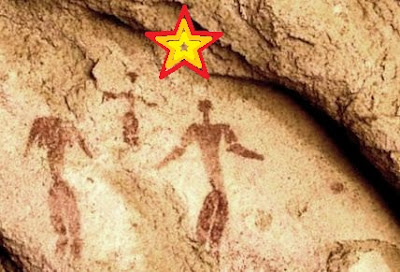Cosmic egg with DNA carved on it.
I am pleased to announce the coveted 2020 C.R.A.P. (Certifiable Rock Art Prevarication) AWARD. This award is given out once a year by RockArtBlog to the most egregious example of Certifiable Rock Art Prevarication (CRAP). The winner this year goes to a well-known fringie and Atlantis researcher Peter Daughtry for discovering a cosmic egg with a picture of DNA carved on it. Daughtry is touted by Graham Hancock, author of “Magicians of the Gods,” previously commemorated on RockArtBlog for his discovery of an extinct toxodon carved on a monolith at Tiahuanaco, Bolivia, (Faris 2019) which must surely lend to his credibility.
“Found by British researcher and author of ‘Atlantis and the Silver City’ Peter Daughtrey, the intriguing object composed entirely out of stone was found in Algarve, Portugal and is believed to date back over 7,000 years. Its peculiar characteristics - like the design of what seems to be the double helix of DNA - makes this ‘cosmic’ egg one of the most intriguing objects found to date. Interestingly, the double helix model wasn’t found until 1953. The obvious questions we need to ask - if it is in fact the Double helix of DNA - is how sugh a symbol could exist on a stone egg that some say was carved approximately 7,000 years ago.” (Ancient Code) This remarkable discovery was made near the town of Silves in the Algarve region of Portugal.
“Archaeological finds have shown that the double spiral is an artistic motif routinely found on a variety of ancient artifacts. Sometimes it is represented as two snakes wrapping around each other or a common stalk, like in the case of Herme’s staff, known as a caduceus, meaning herald’s staff. What boggles the mind is the fact that modern science refuses to make the connection between this archaic symbol and the stuff that makes us who we are - DNA.” (ufoholic)
“Daughtry is convinced this is no coincidence or the result of artistic expression falling down on convergent designs. Furthermore, he believes the proximity of Silves to the Straight of Gibraltar and the Pillars of Hercules might warrant a possible connection to Atlantis. In all truthfullness, if there ever was an ancient civilization that possessed the power to peek inside a cell’s nucleus, the Atlanteans would be a safe bet.” (ufoholic)
So what is a cosmic egg anyway? Many religious creation stories from cultures around the world include a creation by hatching from a cosmic egg. “The concept was figuratively re-adapted by modern science in the 1930s and explored by theoreticians during the following two decades. Current cosmological models maintain that 13.8 billion years ago, the entire mass of the universe was compressed into a gravitational singularity, a so-called ‘cosmic egg’ from which it ‘hatched’ - expanded to its current state following the Big Bang.” (Wikipedia)
So now, in order to give full and proper credit to Peter Daughtry’s discovery we need only believe in mystical cosmic eggs, the lost continent of Atlantis, and that 7,000 years ago these Atlanteans knew about the structure of DNA.
Who better to discover a cosmic egg with a picture of human DNA on it than a man who writes books about the lost continent of Atlantis? Aren’t we lucky that it turned out to have human DNA on it when it created the universe. Who knows what we would have turned out to be if it had something else pictured on it?
And for this momentous discovery, RockArtBlog awards Peter Daughtry and his ‘cosmic egg with DNA pictured on it’ the 2020 C.R.A.P. Award - congratulations.
NOTE: Some images in this posting were retrieved from the internet with a search for public domain photographs. If any of these images are not intended to be public domain, I apologize, and will happily provide the picture credits if the owner will contact me with them. For further information on these reports you should read the original reports at the sites listed below.
REFERENCES:
Ancient Code, Does this 7,000-year-old ‘Cosmic Egg ‘depict the earliest illustration of DNA?, https://ancient-code.com
Faris, Peter, 2019, Extinct Animals in Rock Art - the Tiahuanaco Toxodon, February 16, 2019, https://rockartblog.blogspot.com/search/label/Tiahuanaco.























































